Mansfield and District Light Railway
History
Mansfield's standard-gauge, overhead electric tramway, which was owned and operated by the Mansfield and District Light Railways Company, opened to the public at 5pm on the 11th July 1905.
The M&DLRCo, which had been incorporated on the 15th May 1901, held powers granted in 1900, 1902 and 1903; although the first powers were for circa 6 miles of 3ft 6ins-gauge tramway, the later orders not only extended the mileage but also authorised a switch to standard gauge. The company however, had trouble raising the finance, eventually being forced to sell out, the start of construction being delayed until January 1905.
The system was opened in stages between the 11th July 1905 and the 26th November 1906, and though further powers were obtained in 1907, only one extension was ever constructed — Crown Farm; opened on the 13th April 1911 — this taking the system to its final size of 12.28 miles, a fairly substantial system for a moderately sized town.
The tramway consisted of five lines radiating from the Market Place: northwards along Woodhouse Rd, Yorke St and Sherwood St, before turning northeastwards along Station St to a terminus in High St, Mansfield Woodhouse; eastwards along Eakring Rd to Crown Farm; southwards along Nottingham Rd to Berry Hill; southwestwards along Stockwell Gate, Sutton Rd, Mansfield Rd and Outram St in Sutton-in-Ashfield, where it turned westwards along Forest St, Alfreton Rd and Hucknall Lane to a terminus on Sutton Rd in Hucknall-under-Huthwaite; and lastly, northwestwards along Westgate, Chesterfield Rd and Mansfield Rd to a terminus at the latter's junction with Hill St in Pleasley. The system was always isolated, the nearest tramways being those of Chesterfield Corporation, the Nottinghamshire and Derbyshire Tramways Company and Nottingham Corporation Tramways, all around 8 to 9 miles distant.
The tramway was under-financed, so struggled with cash-flow issues, both during construction and for the first year or so of operation. The undertaking was eventually restructured — on the 7th December 1906 — with the formation of Mansfield and District Tramways Limited (a holding company), this being done under the the guidance of Andrew Beatty, who had been invited onto the board earlier that year, and who would go on (in 1909) to form Balfour Beatty and Company Limited. This intervention turned the tramway's fortunes around, such that by 1909 it was not only able to pay a dividend to its preference shareholders, but also to set aside money in the form of a depreciation fund.
Balfour-Beatty and Company eventually took full control of the M&DTL, the latter's M&DTCo shares being transferred to another BB&Co subsidiary — the Tramways Light and Power Company — in 1912. BB&Co had been founded to promote, purchase, or otherwise acquire interests in tramways and electric supply companies across the United Kingdom, a policy which would eventually see it control the following systems: 1909 (Dartford Council Light Railways; Dunfermline and District Tramways; Llandudno and Colwyn Bay Electric Railway; Llanelly Tramways; Luton Corporation Tramways); 1911 (City of Carlisle Electric Tramways); 1912 (Leamington and Warwick Electric Tramways; Mansfield and District Light Railway; Nottinghamshire and Derbyshire Tramways); 1914 (Cheltenham and District Light Railway); 1920 (Falkirk and District Tramways); and lastly, in 1922 (Wemyss and District Tramways).
All bar one of the M&DLR's lines served newly opened collieries, so the tramway was very dependent on the prosperity of the mining industry, ferrying miners to and from work at the start and end of their shifts. It was almost certainly the importance of the mining industry that enabled the company to obtain dispensation from the government to order four new tramcars during the Great War, an authorisation granted to only a handful of tramways during the conflict. The war however soon brought about a loss of men (and their skills), as well as severe difficulties in obtaining spares and track, a minimal maintenance regime reigning for the best part of four years. As a result, the tramway emerged from the conflict in run-down condition, though the company quickly set about catching up on the backlog of repairs, as well as making plans for extensions, despite not having built all those it acquired powers for in 1907.
The company's aspirations were however soon impacted by the hard economic realities of the post-war world (dramatically increased costs and difficulties raising finance), the result being that the sanctioned lines were never built. However, and in spite of the prevailing economic conditions, the company still found the money to double sections of single track and to carry out a programme of tramcar rebuilding, strongly suggesting that it still had every confidence in the future of the tramway. The company was nevertheless also quick to exploit the potential of the motorbus, and having first dipped its toes in the water on the 29th May 1914, it expanded its own motorbus services steadily from 1919 onwards.
In November 1921, the Tramways Light and Power Company was renamed, becoming the Midland Counties Electric Supply Co Ltd; although it continued to own the M&DLR, as well as the Midland General Omnibus Company and the Nottinghamshire and Derbyshire Tramways Company (two other local BB&Co transport undertakings), all were operated as part of a single coordinating group called the 'Midland General Group'.
The M&DTL's faith in the tramway was still in place in 1925 when further extensions were applied for, which though granted, came only after vociferous objections from Mansfield Corporation, which now viewed the tramcar as an anachronism that would be better gone from its streets; whilst much of this change in attitude can be ascribed to a desire to modernise, the fact that the corporation no longer supplied electricity to the tramway — this having been taken over by another BB&Co undertaking, the Derbyshire and Nottinghamshire Electric Power Company — undoubtedly also played a role. The extensions were never built, and though the company ordered two new tramcars that year (1925), it was now suffering heavily from motorbus competition, the tramway being particularly susceptible to this due to the relatively rural nature of its lines.
By the late 1920s, the area was suffering from a serious downturn in the mining industry, and it was clear that the tramway could not last much longer without major investment, money which the company simply did not have. Although the company had been particularly badly impacted by the General Strike of 1926, failing to pay a dividend the following year, it was encouraged by the recent success of its sister system — the N&DTCo — which in 1928 had not only obtained powers to convert its tramway to trolleybus operation, a much-favoured form of traction at this time, especially where the tramway owner also owned the electricity generation infrastructure, but they had also secured protection from motorbus competition. Powers were therefore sought, and duly granted on the 10th May 1929, which though authorising the replacement of the tramway by trolleybuses, they crucially failed to provide the same level of protection as had been afforded to the N&DTCo. The act also authorised a change of name to the Mansfield and District Traction Company, to reflect the proposed switch to trolleybuses, a change which was destined not to happen.
There now followed a series of disagreements with Mansfield Corporation over requirements for road widening (for the trolleybuses), all of which were of course expected to be done at the expense of the company; the latter eventually lost patience and decided to replace the trams with motorbuses, something that the corporation had been angling for since the mid-1920s.
The first tramway services were withdrawn on the 17th September 1932, the last trams of all running just three weeks later on the 9th October; the new motorbus fleet, 45 strong, took over the following day.
Uniforms
For the first 15 years or so of operation (1905 to around 1920), motormen and conductors were issued with single-breasted jackets with five brass buttons (bearing the full system title and a monogram of intertwined system initials — see link), two breast pockets (with button closures), epaulettes and upright collars; the latter carried an employee number in individual brass numerals on both sides. Caps were in a military style with a glossy peak and tensioned crown (top); they bore a one-piece, brass cap badge composed of the system's initials: 'M&DLR'. Several photos exist which show tramwaymen in uniforms, but without the collar numbers; these were probably individuals who were either in a probationary period, or were in some way considered temporary.
Standard, 'off-the-shelf' grade badges — Motorman or Conductor — appear to have been introduced around the time of the Great War, becoming more prevalent in the 1920's. probably because they were cheaper and easy to order than the M&DLR pattern cap badges. Towards the very end of services, Driver grade badges also started to be used.
In the mid-to-late 1920s, or possibly the early 1930s, the style of the uniform jacket was changed to a more modern cut. In the case of conductors, although the design remained single-breasted with two breast pockets and epaulettes, the upright collars were replaced by lapels, so that the bearer's shirt and tie were now on view. The same approach was also taken for motormen, but with the jacket being double-breasted.
Tramcar staff were also issued with double-breasted greatcoats with five pairs of buttons, epaulettes and high-fold-over collars; these garments do not appear to have carried any insignia.
Photographs of inspectors are yet to come to light, so it is currently unknown what uniforms they wore, though the 'last day' photo below suggests that they may have worn identical uniforms to those worn by motormen and conductors.
In common with the vast majority of UK tramway operators, the M&DLR employed women during the Great War to replace men lost to the armed services; unlike most systems, these ladies were employed not only as conductresses, but also as motorwomen. They were issued with tailored, single-breasted jackets with five buttons, a waist belt (with button fastening) and lapels; the latter do not appear to have carried any insignia. Headgear took the form of a baggy cap with a glossy peak, and these variously carried the standard 'M&DLR' cap badge or a grade badge, probably whatever was available. The usual array of Great War regimental sweetheart badges were probably also worn, though photographic evidence is currently sparse.
The ladies also appear to have been issued with standard, male, double-breasted greatcoats with five pairs of buttons, epaulettes and high, fold-over collars.
Further reading
For a history of the Mansfield and District Light Railway, see: 'Mansfield's Trams' by Tony Hurst; Irwell Press (2002).
Images
Motormen and conductors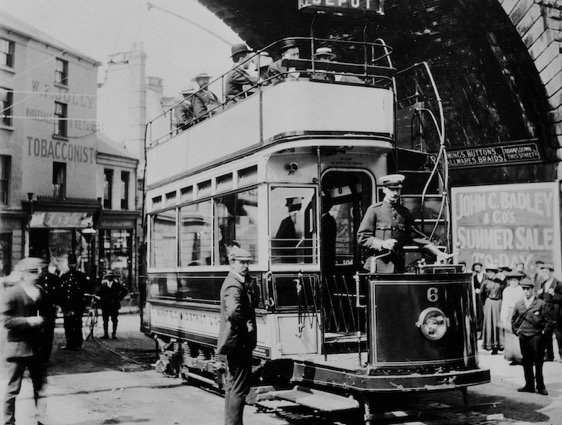
Tramcar No 6, carrying the official Board of Trade inspection party, poses for the cameraman in Albert St on the 11th July 1905, the system opening later that day. Photo courtesy of the National Tramway Museum.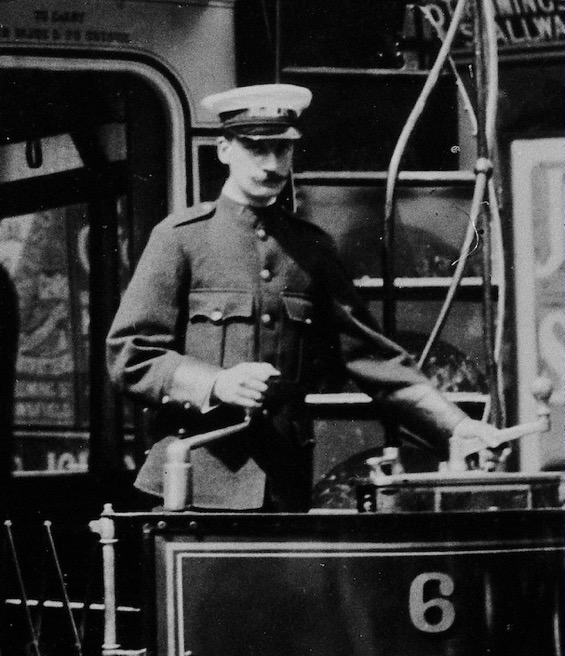
An enlargement of the above photo showing the motorman. His collars possibly carry the employee number '1', whilst his cap carries a one-piece system initials badge (see below).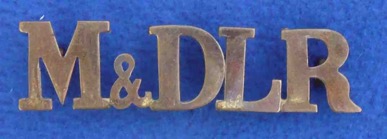
Mansfield and District Light Railway cap badge — brass. Author's Collection.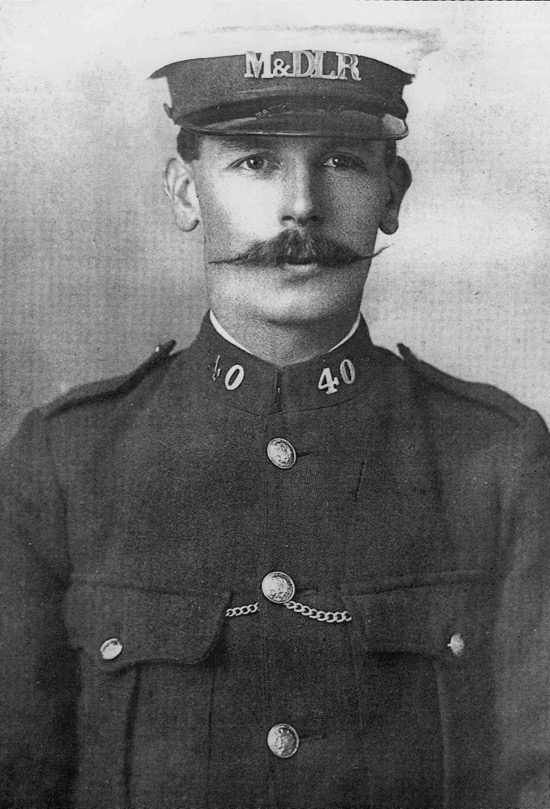
This photo purportedly shows M&DLR Employee No 40, Charles Robert Walker; however, given that Mr Walker was at various times, the tramway engineer (during construction), the General Manager and the Secretary, it seems extremely unlikely that he would, given the seniority of these roles, have been issued with an ordinary uniform. This leaves two plausible explanations, either he was modelling the uniform, or the photo is in fact not of Mr Walker. With thanks to the Old Mansfield Society.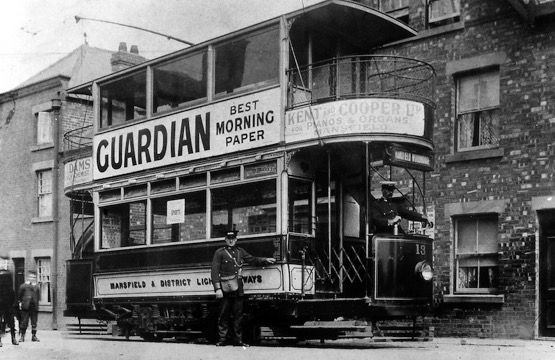
An M&DLR conductor and a motorman stand at the terminus at Mansfield Woodhouse in 1907 with a fairly pristine Tramcar No 13, which had been delivered the year previously. Photo with acknowledgement to the Midland General Omnibus Company website.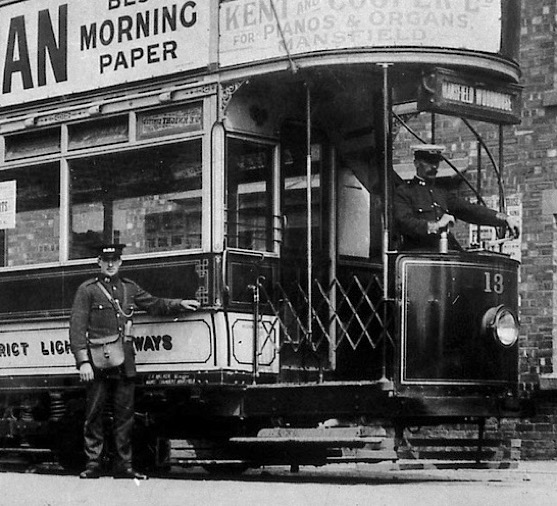
A blow-up of the above photo showing the conductor and motorman, both of whom are wearing single-breasted jackets with upright-collars, epaulettes and military-style caps.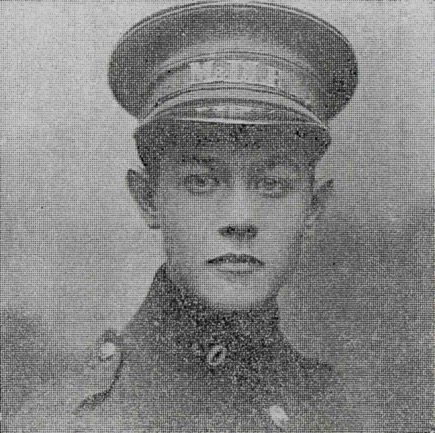
Employee No 30, Harry Witts (or possibly Whitt), who is known to have served as both a motorman and a conductor in 1915, when he would have been only 14 years of age. Photo courtesy of Tony Hurst.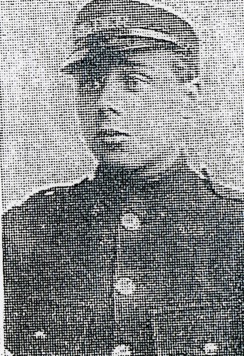
A poor-quality reproduction unfortunately, showing George Waterfield — without an employee number — who is known to have been employed during 1918, though in what capacity is unclear. Although his cap would appear to be a kepi, it is almost certainly a standard cap, the crown of which is difficult to discern due to the poor quality of the image. Photo courtesy of Tony Hurst.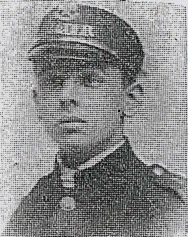
Fred Stevens, who was employed by the company as a motorman in 1920, and later became an inspector. The badge above the 'M&DLR' badge is more than likely a regimental badge, strongly suggesting that the photo was taken during the Great War; the absence of an employee number also suggests that he was perhaps only employed in a probationary or temporary capacity when the photo was taken. Photo courtesy of Tony Hurst.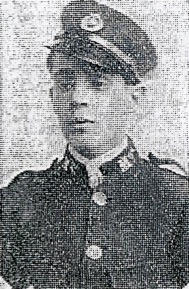
Jess Bickley, who is known to have been in the employ of the company in 1918, purportedly as an inspector, though here he appears to be a motorman. The cap badge is probably a regimental badge, the wearing of which was very common during the Great War. The collar initials appear to be 'M9', 'M' presumably standing for 'Motorman'. Photo courtesy of Tony Hurst.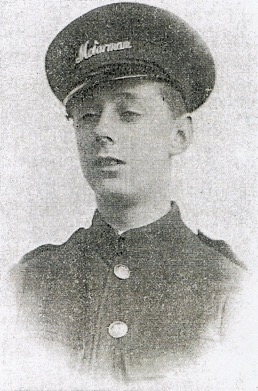
John Lamin (or Lamming), aged 17. He has neither an employee number nor the standard system initials cap badge, possibly indicating that he was in a probationary phase, though this is mere speculation. Photo courtesy of Tony Hurst. 
Standard, 'off-the-shelf', script-lettering grade badges — Motorman or Conductor — of the type introduced by the M&DLR from around the Great War onwards. Author's Collection.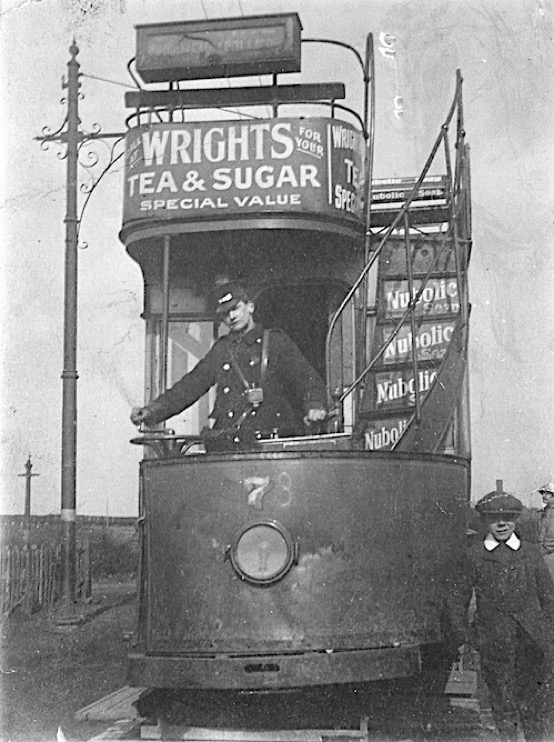
A very battered-looking Tramcar No 7 at the Crown Farm terminus — photo undated, but judging by the condition of the vehicle, probably taken in the late 1920s. The only insignia worn by the motorman is a one-piece M&DLR cap badge. Photo courtesy of the National Tramway Museum.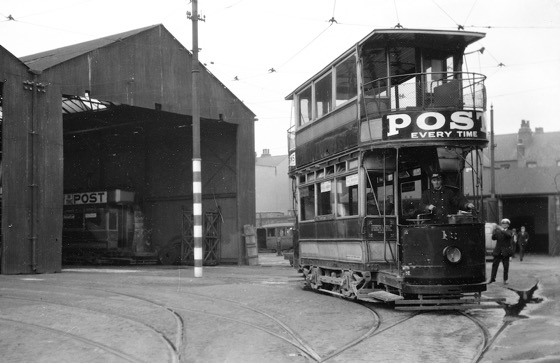
Tramcar No 13 again, this time preparing to leave the depot in 1930, with the motorman in double-breasted greatcoat and the conductor (with trolley pole) in single-breasted jacket with lapels. Photo believed to have been taken by Dr H Nicol, courtesy of the National Tramway Museum.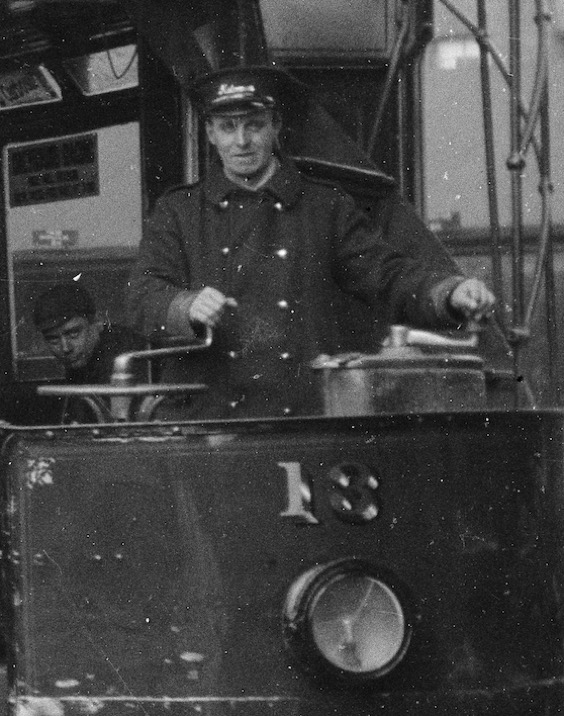
An enlargement of the above photo showing the motorman, whose greatcoat is completely devoid of insignia. His cap bears a standard, Motorman grade badge.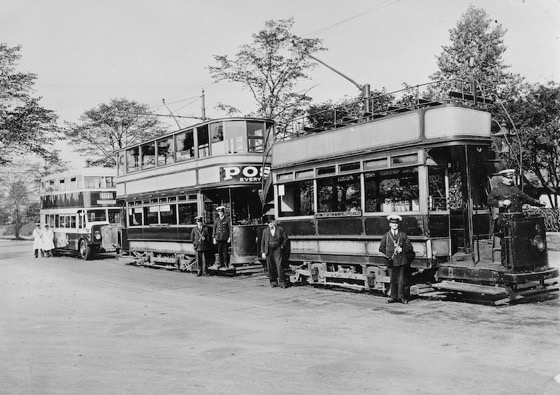
A photo taken on the last day of operation, 9th October 1932. The man at the controls of Tramcar No 6 is in fact Chief Inspector Charlie Underwood, which strongly suggests that senior grades wore uniforms that were identical to those issued to motormen and conductors. The other motorman (Alf Cooke) is wearing a double-breasted jacket with lapels, whilst the two conductors, B Groves (extreme left) and D Moreton (centre) are both wearing single-breasted jackets with lapels. Photo courtesy of the National Tramway Museum.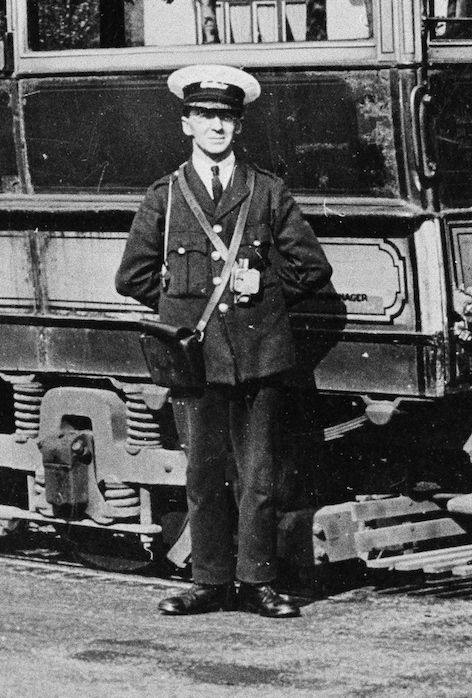
An enlargement of the above photo showing Conductor Moreton in single-breasted jacket with lapels, and with a Conductor grade badge on his cap.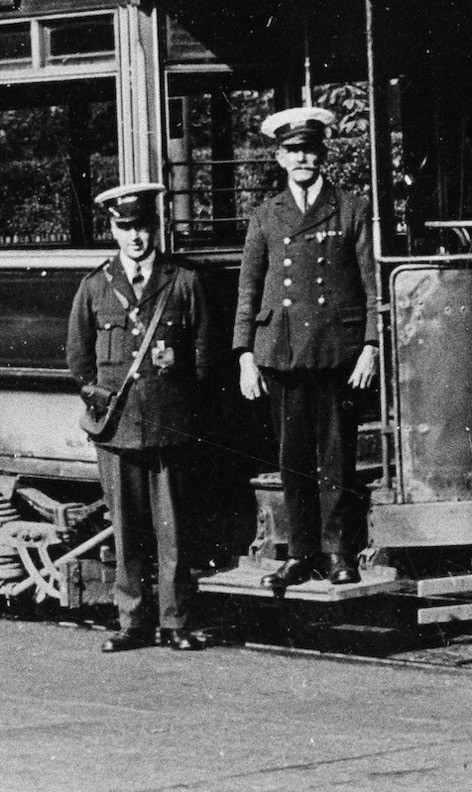
Another enlargement of the above photo showing Conductor B Groves and Motorman Alf Cooke, the latter in double-breasted jacket with lapels, and with a Driver grade badge on his cap.
Female staff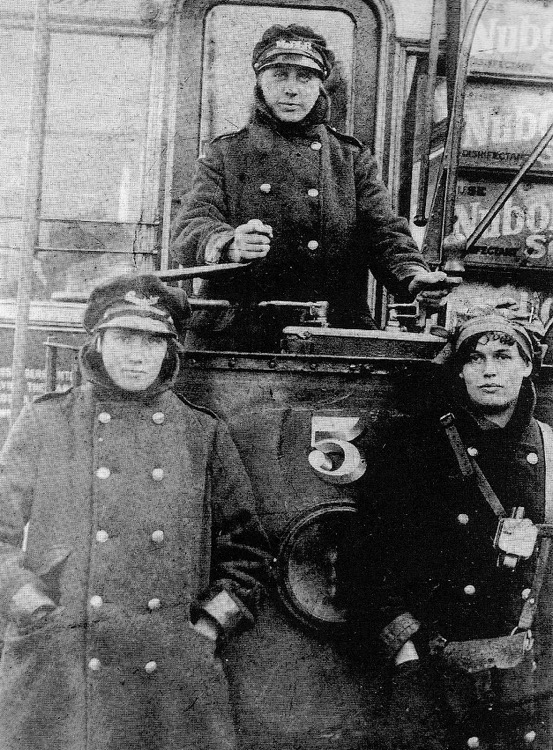
Two conductresses and a motorwoman with a rather battered-looking Tramcar No 5 — photo undated, but almost certainly taken during the Great War. The lady on the left has a Conductor cap badge, presumably because the M&DLR cap badges were in short supply and would have needed a special order, whereas Conductor cap badges would have been an 'off the shelf' item. With thanks to the National Tramway Museum.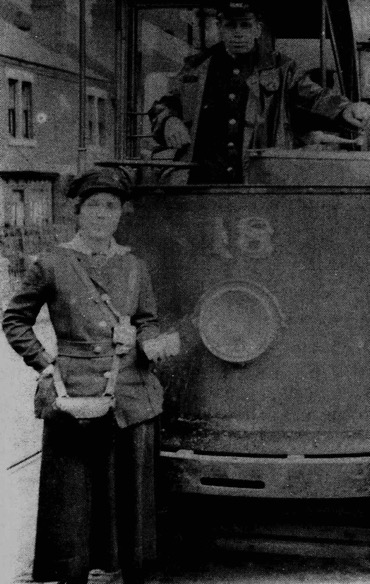
A poor quality photograph, but one which does show show a Great War tram conductress (a Mrs Stocks) without a greatcoat, thus revealing details of the uniform worn underneath. The photo is believed to have been taken around 1918, the motorman is Robert Bedford. Photo with acknowledgement to Joan Sheldon, courtesy of Tony Hurst.